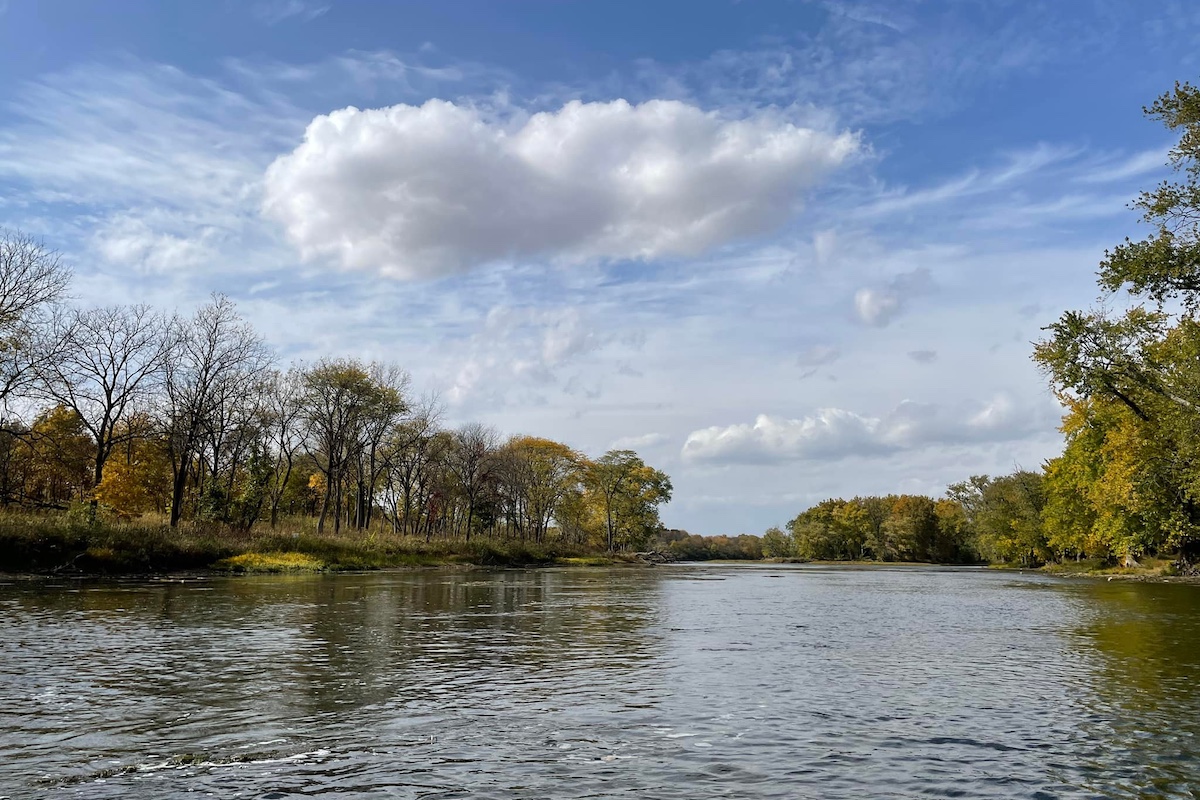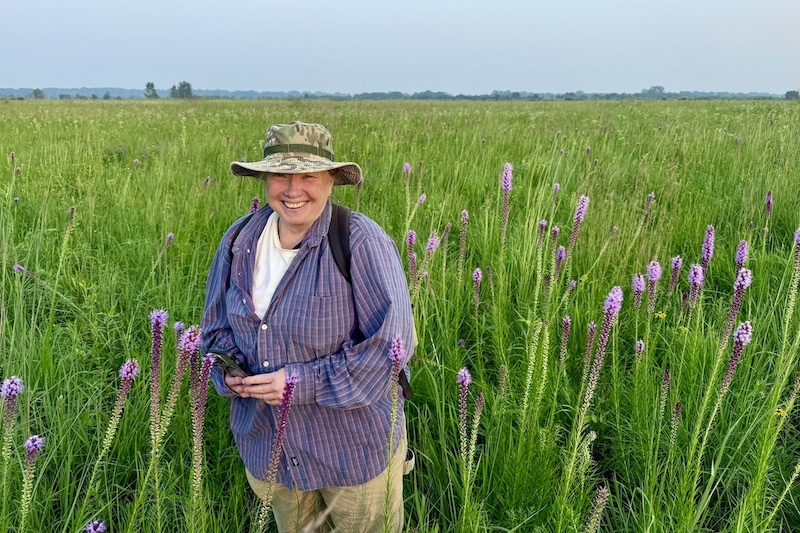
Kankakee River Nature Preserve consists of numerous of tracts land within and near Kankakee River State Park. Photo by Friends of Langham Island.



Kankakee River Nature Preserve consists of numerous of tracts land within and near Kankakee River State Park. Photo by Friends of Langham Island.
Known as “The Island of Rare Plants,” Langham Island has a history of both grim abuses and miraculous recoveries.
When first studied by a botanist in 1872, this little island in the Kankakee River was found to have an extraordinary number of species that were then very rare – and now are on endangered species lists. Unique among these is Kankakee mallow (Iliamna remota), known to be native nowhere else on the planet. How could a plant survive only here, and why were so many other rare plants with it?
The mallow seemed lost from the island when the Illinois Native Plant Society sponsored a canoe tour there in 2014. The state of this Illinois Nature Preserve ecosystem shocked the visitors. Indeed, most flora seemed lost, and the island had become a dismal tangle of thick brush due to lack of needed fire. But volunteer stewards started cutting and burning on September 13, 2014, and mallow seedlings were noticed emerging from the remains of burn piles on October 25. That plant wanted to be saved! Since 2014, volunteer stewards have been working to restore the island ecosystem. These days, they work weekly on alternating Saturdays and Thursdays, at least on days when water or ice are not too dangerous to reach the island. (Everyone is invited to chip in).
The second rarest plant was the leafy prairie clover (Dalea foliosa), subject of the current drama. It had been thought entirely lost from Illinois for a hundred years (surviving on Earth mostly in “poor and declining” populations in Tennessee and Alabama).
Here’s the story of the leafy prairie clover on Langham, as told by the first person to start caring for the island’s ecosystem, botanist John Schwegman:
The leafy prairie clover (Dalea foliosa) was first discovered on the island on August 27, 1872 by E. J. Hill. He found it growing on “gravelly banks.” Realizing he had discovered a little-known species, he returned July 28, 1873 to collect more.
In a letter to Harry Patterson dated November 29, 1873, Hill, referring to the leafy prairie clover, writes “In fact I found but five plants after thorough search. Four of these I dug up, sending two of the roots to Dr. (Asa) Gray, to cultivate, fearing I might exterminate; the other was left.” This species has not been seen on the island since.
Employed by the Illinois Department of Natural Resources, John Schwegman and colleague Bill Glass worked to restore ecological health to the island from 1983 to 2003 by cutting brush and burning. During that time, they also attempted to restore the leafy prairie clover by scattering seeds from populations discovered by Jerry Wilhelm starting on August 7, 1974, in nearby Will County.
Every year the volunteers have kept an eye out for leafy prairie clover plants. Legume seeds may wait for many years before germinating. Young plants don’t bloom. Deer may eat unprotected plants, which may then die, or which may sprout again and start building up enough root resources to bloom.
On Thursday July 17, 2025, the Friends of Langham Island volunteer stewards were hard at work pulling invasive sweet clover. One of the stewards, Karen Horn, wandered down the steep slope on the northwest side of the island, more than her legs were altogether comfortable with. She hadn’t been that far for at least two years, she said. But she had to go where the sweet clover was. Suddenly into her vision popped this phantom plant. She didn’t know what it was, but she knew it was unfamiliar. She queried iNaturalist, which responded “leafy prairie clover.” She texted two pictures of the plant, without any comment, to Ryan Sorrells. Sorrells, a botanist and Langham Island expert, immediately called her and asked, “Karen, where are you?” He confirmed the plant was leafy prairie clover and suggested we find a way to protect the plant from deer browsing and that Kim Roman of the Illinois Nature Preserves Commission and IDNR be notified. It was the first sighting on the island since 1873.

Some volunteers are not as young as we used to be. Only one elected to go up and down the steep and unstable slope that late in the day. Steve Bohan found some unused cage material, and young Craig Goodwin raced with it to Karen Horn’s side. In the foreground of the photo are Goodwin’s loppers and “Buckthorn Blaster” herbicide container. Normally to cage a plant from deer, you drive stakes into the ground for stability. But this area was solid rock, thinly covered by stones and river flotsam left during floods. It’s a challenging habitat, but this plant is known for living in shallow soil over bedrock. It faces hardships and finds its way under conditions where most other plants can’t. Goodwin and Horn made a tent of caging over the prairie clover and weighed down its edges with heavy rocks.
Legume seeds sometimes lie in the soil for long times, protected by impervious seed coats. Did this plant come from the seeds that Schwegman planted so many years ago? Good people will study it.
Stories of discovery like this one are special, but not altogether surprising: dedicated volunteer stewardship communities not only increase the amount of careful management that sites such as Langham receive, but also the number of people familiar with the site’s conservation priorities, capable of noticing and acting on discoveries like the one described here.
Congratulations to Karen Horn, Craig Goodwin and the whole team. Their dedication has worked so many wonders, and this is another.

Stephen Packard was a Field Representative with the Illinois Nature Preserves Commission before becoming Illinois Stewardship Director for The Nature Conservancy. He helped start Friends of Langham Island and Friends of Illinois Nature Preserves.
Submit a question for the author